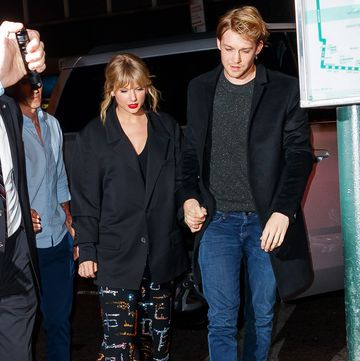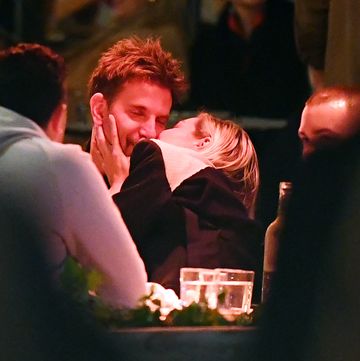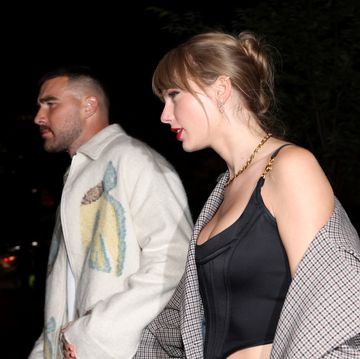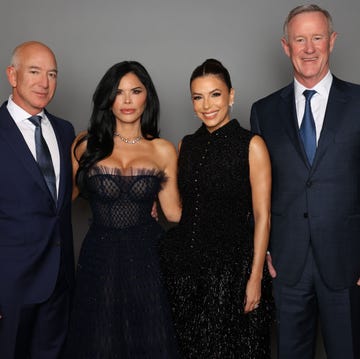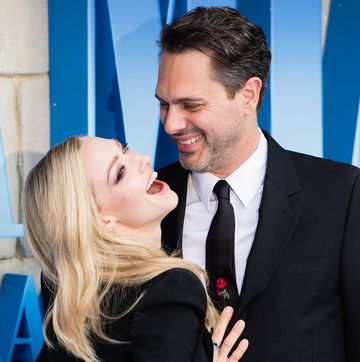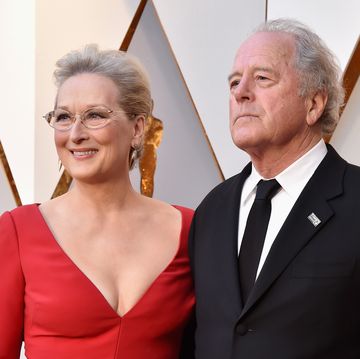Like schoolteachers and bosses, celebrities tend to be either intimidating or likable but rarely are both. With stars, it's a matter of the little things: eye contact; warmth or a lack thereof; whether they insist on being flanked by an entourage; and how seriously they take their job or, worse, themselves. If you were to judge Joan Smalls on her modeling work, you might designate her a member of the "intimidating" camp. You would be incorrect.
Related: The Return of the Supermodel: It's Joan Smalls
Smalls arrives sans entourage at SoHo's The Mercer Kitchen and peers around the room with a shy smile until she spots the stranger waving at her and zooms over. Originally, the restaurant had been unable to offer a table other than a calamitously loud one at the bottom of a staircase, but within 60 seconds of Smalls' arrival, a prime corner spot miraculously becomes available. Who could begrudge the gatekeepers, though? Smalls, at 5'10½" and with limbs out of an Antonio Lopez sketch, is possessed of thoroughbred looks that hark back to American beauties like Ali MacGraw and Candice Bergen. The hair is long and straight, the bone structure aquiline, the smile dazzling. No wonder Smalls is kicking up the kind of fashion-industry excitement that comes along only a handful of times each decade. Over the past year, she has snagged the number-one spot on Models.com, having pulled in a rumored $3.5 million—making her the eighth-highest-paid model in the world, according to Forbes. "You get a sense of who is going to become an icon," says Givenchy creative director Riccardo Tisci, known as something of a model whisperer. "Since the moment she walked into my couture salon, I knew that a star was born."
Related: From Tomboy to Supermodel: Charting Joan Smalls' Runway Rise
As she settles into the booth, placing a structured lavender bag (designed by Tisci, naturally) next to her on the banquette, the 24-year-old attracts a certain kind of stare from the well-heeled crowd: It's not a look of recognition, exactly, but rather of I-know-I've-seen-this-creature-but-I-don't-know-where. And that makes perfect sense. Surely they've glimpsed Smalls some place or other—in campaigns from Versace to Prabal Gurung to H&M, on the Victoria's Secret runway, in ads for Esteé Lauder. In a way, I've-seen-this-creature-but-I-don't-know-where is the pinnacle of compliments for a model: It means her beauty is specific enough to induce déjà vu but universal enough to avert pigeonholing.
"I came to New York with a dream," Smalls says, shrugging off a Rag & Bone jacket borrowed from her boyfriend of four years, entrepreneur Bernard Smith. "I came to do what I saw girls doing in campaigns, in editorials—great things, challenging things." Beneath the coat, she's wearing the uniform of her profession, which by definition must include Balenciaga boots (check), skinny black leather Alexander Wang pants (check), and Catbird earrings (check-check-check-check-check-check: She's wearing six of them!). The earrings were procured near her home, in Williamsburg, Brooklyn, where she's chosen to live because it provides psychological distance from her modeling life: "I like to detach myself from work, to be able to go home and switch it all off, but I like looking into the city." As it happens, Smalls has resided in Brooklyn and Queens but never Manhattan; she jokes that she's going to keep orbiting the city's glitziest borough until she ends up in Staten Island.
Perhaps she's also drawn to the outer boroughs' marginally quieter pace. Smalls hails from Hatillo, Puerto Rico, a coastal town of 42,000 residents and possibly even more cows, some of which liked to wander onto the Smalls' family property from a neighboring dairy farm. The daughter of an accountant and a social worker, she grew up roving around her family's six acres, amassing a tomboy's collection of knee scars, and earning the nickname Jodona ("it means 'little pest,' " she says, chuckling) from her two older sisters. The girls were raised to be "respectful and respectable," as Smalls describes it: "To speak well and clearly, and carry ourselves with pride." It's a breeding that reads as old-fashioned politesse: Smalls sits up straight. She doesn't punctuate every other word with like or clock her appearance in every reflective surface or compulsively check her e-mail. (In fact, not once during lunch does her phone make an appearance. We could all learn from that.)
Growing up in Puerto Rico, Smalls drew her first conception of fashion from the local beauty-pageant culture. She was curious about modeling, but it "was never a real idea, because the aesthetic of beauty was so different from my body type. They love a curvier woman, light skinned, of average height." Smalls says this with a ripple of laughter, gesturing at her frame. It was only after catching E! True Hollywood Story episodes about Naomi Campbell and Heidi Klum, women built more like her, that the idea began to make sense.
At 19, Smalls put the dream into motion. She moved to New York, slept on an air mattress at her aunt's house in Queens, and picked up a trail mix of jobs—Nordstrom catalogs, a Target commercial, a Ricky Martin video, print ads for Liz Claiborne. Not bad work, but scaling fashion's upper echelons took more time and perseverance, including a trip to Paris on her own dime in an attempt to line up an agent there. The breakthrough came in summer 2009, when Tisci—who has since been home to Puerto Rico with her and met her parents—took one look at her and put her on exclusivity for Givenchy's couture presentation. This was roughly the equivalent of transferring from community college to Harvard: One minute Smalls was shilling microfiber push-up bras, the next she was wearing Chantilly lace next to Natasha Poly and Mariacarla Boscono.
In the years since, she has calmly checked off the high-end boxes: campaigns for Gucci, Fendi, and Givenchy; dozens of runway jaunts each season; and—the golden ticket—a beauty contract with Estée Lauder, which made her the first Latina to score a worldwide campaign for the brand. "The word supermodel is overused, but if there's any woman of our generation who deserves the title, it's Joan," says Estée Lauder's global creative director Richard Ferretti. "She can go from looking girl-next-door to superchic-tough-strong—and she is all of that." Plus, he adds: "She has the perfect face."
Even in her profession, perfect is rare. Over the past decade, suddenly—thankfully!—modeling has expanded to include a wider spectrum of mannequin: We've had girls with epic foreheads, girls with alien eyes, girls with gap-toothed smiles. To be clear, this is a good thing; variety is as much the spice of fashion as it is of life. But every once in a while, a girl like Smalls comes along to remind us of the power of classic beauty. "Her obvious beauty, to me, is unparalleled and exquisitely unique," says Prabal Gurung, who calls her "my Joan of Arc" and counts her as the muse for most of his collections. "It's a face that makes you imagine the wildest things."
Smalls wasn't always so lavishly appreciated. Today, makeup artist Tom Pecheux refers to her coloring as "that gold skin tone that everybody would pay to have." Ferretti says, "Her skin tone alone—I don't know what it is, it's so beautiful." But before it became a trademark, it was an issue. (That is not a sentence that should be written in the twenty-first century, by the way, but there it is.) "I made a list of agencies and went to all the open calls," Smalls remembers. "One of the agents looked me over and said, 'Joan, I'd love to represent you, I think you're great, but you have to straighten your teeth.' " She was perplexed. "Why do I have to straighten my teeth?" she asked. "I see models with crooked teeth all the time." The agent looked her square in the face: "Joan, those models are Caucasian, and you're not. You're a black model. And it's already a challenge."
Smalls' response to the evaluation? "I wasn't bothered by it," she says. "I appreciate honesty. I don't like people beating around the bush." At this she pauses, twisting a napkin into a tight little roll and bonking it on the table for emphasis. "I thought, You know what? I'm going to take that as constructive criticism. I'm going to take my ass back to Puerto Rico, straighten my teeth, and come back." She did exactly that, enrolling in college while her teeth were in braces and graduating magna cum laude with a bachelor's degree in psychology, because why not? She still laments missing summa cum laude "by two points!" In other words, the maturity and intelligence Smalls radiates in pictures is no act. She has navigated this career from a position of relative power—that of a bona fide, degree-holding grown-up. "Frankly, Joan is really smart," says Ferretti. "She doesn't do anything by accident. She's intelligent, and clever, and a good businesswoman—she has a lot of ands—and that's a rarity."
Smalls is deliberate and impassioned when she talks about the industry's problems with diversity. "Fashion should be about creativity and visionaries, and last time I checked, the world is a multicultural place. Why shouldn't a little girl from Puerto Rico see the runway and think, I can wear that?" She pauses, gathers her thoughts: "People hide behind the word aesthetic. They say, 'Well, it's just that designer's aesthetic.' But when you see 18 seasons in a row and not one single model outside a certain skin color…?" She raises an eyebrow. "There are people in the industry who are advocates, who support diversity. And there are people who do not. I don't get it. Beauty is universal. These doors have to open." She's right, of course. Fashion is a global industry, and most of the globe looks more like Smalls than it does her competition. Designers who tend toward starkly monochromatic runways are only diminishing their own relevance.
As a counterweight, Joan's cheering section within the industry is both extensive and star dusted: Michael Kors raves that "she's supersmart, a lot of fun, and she loves to cook up a storm—what's not to love?" Photographer Michael Thompson, who captured her chameleonic powers in these pages, praises her as a trouper who cheerfully endured "extreme pain" while jumping in heels on command. And Karlie Kloss, Smalls' friend and closest industry contemporary—they hit it big at the same time—applauds her backbone: "She's very strong and proud of who she is. She doesn't conform and try to please." (Pecheux, adoringly, puts a finer point on it: "You cannot bullshit her at all. Don't pretend the dress fits perfectly if it doesn't, because she knows, and she will tell you, 'No, that doesn't look good on me.' ")
Smalls has fortitude, but she's also just plain strong: an athlete in front of the camera, her body is her tool. She suffers from scoliosis, and to manage the pain, she works out like a Trojan, at the gym in her building, with a trainer, and at a class called Bodyburn ("they say it's like Pilates on crack," she laughs).
Which may be why, when our food arrives, there's a moment of confusion as the server mistakenly gives Smalls the shrimp cocktail and me the macaroni and cheese (an understandable assumption). The shrimp comes with a mini Tabasco bottle the size of a thumbtack, which cracks Smalls up—she laughs easily, important for a person whose job involves walking the Victoria's Secret runway wearing little more than go-go boots and what looks like a giant tube of silver-painted cannelloni around her neck.
This ready animation—plus a pair of Bacall-caliber eyebrows—makes me wonder if Smalls has any ambitions for acting, and indeed she does (she read for 12 Years a Slave but, rumor has it, was considered too beautiful to cast). But in this, as in other things, her approach has been pondered, her motivations examined: "I want to be clear that I don't want to act just because it's the typical move for a model. Everyone wants to be an actress, for God knows what reason! Fame, I guess." Her desire "comes from a place of wanting to entertain people on a different level." And also from her love for film, which tends toward "scary movies, psychological thrillers, and anything drama driven that pulls you in and keeps you guessing." (Reader, her movie recommendations for you include the original The Exorcist and I Saw the Devil, a prizewinning but little-known South Korean thriller.)
The pulpy movie jones is unexpected in someone with that kind of innate elegance, but there you go. Even Kanye West bows down to the Smalls refinement: In the song "Christian Dior Denim Flow," he uncorks an innuendo-laced roll call of models, detailing the, um, zestful activities with which he wishes to engage Lara, Stam, and Abbey Lee. But Joan? "Make a phone call, out to Joan Smalls," he raps, leaving it at that—a rather respectful approach in its context. Not even Kanye's active imagination can dethrone Ms. Smalls.


